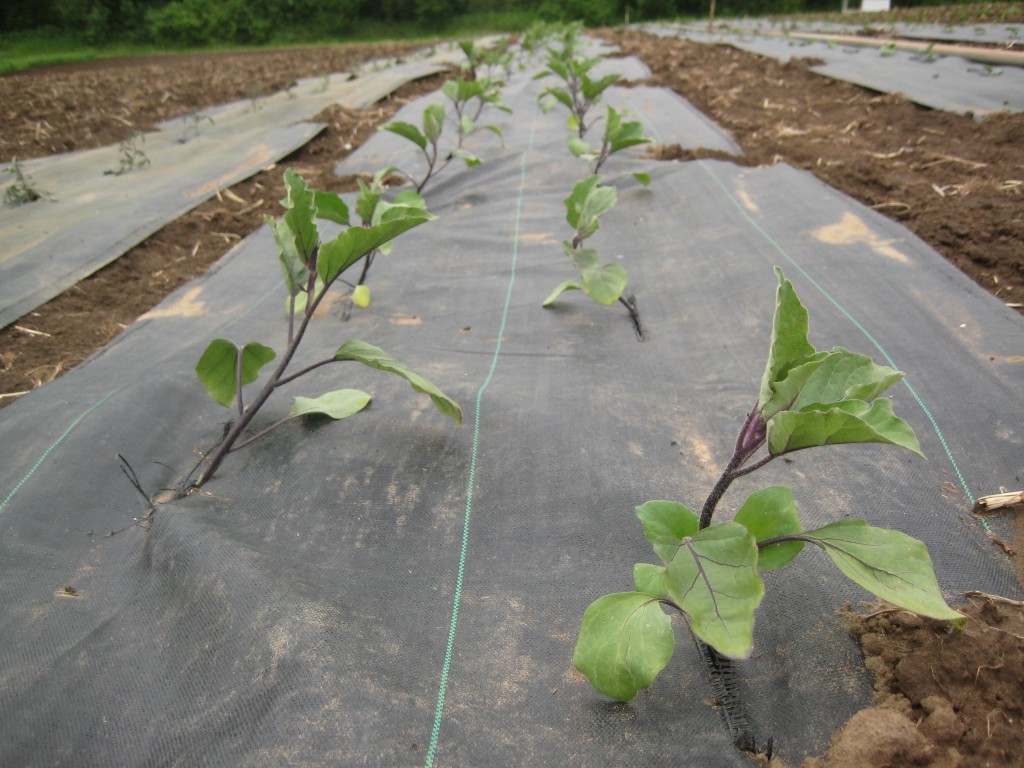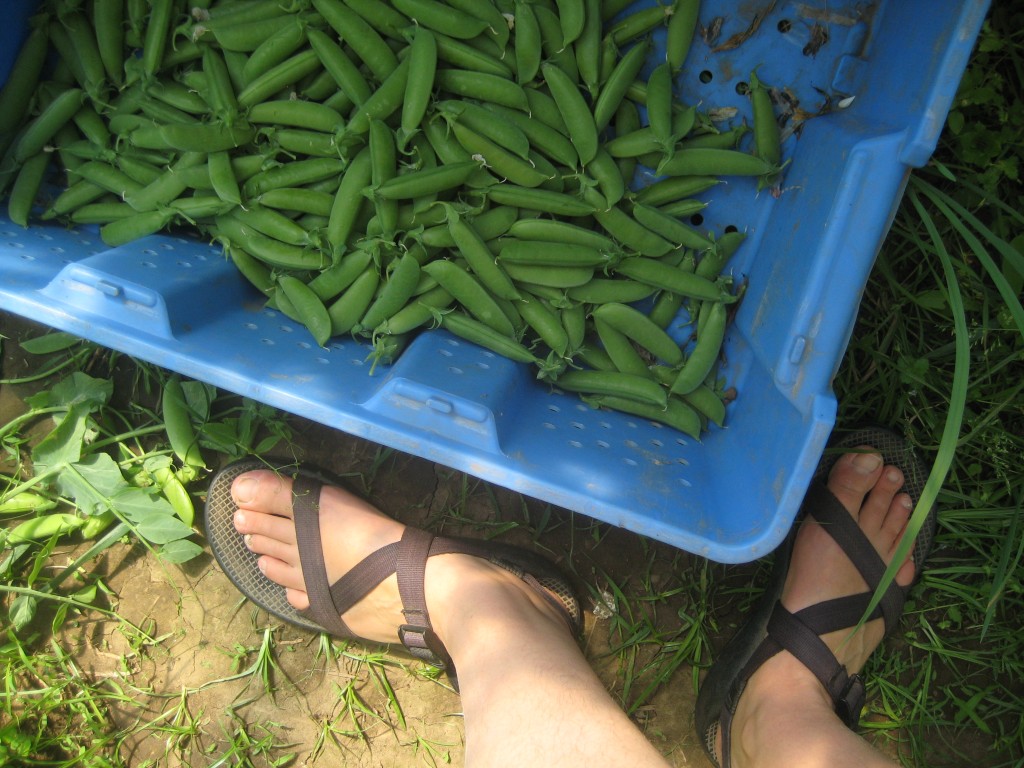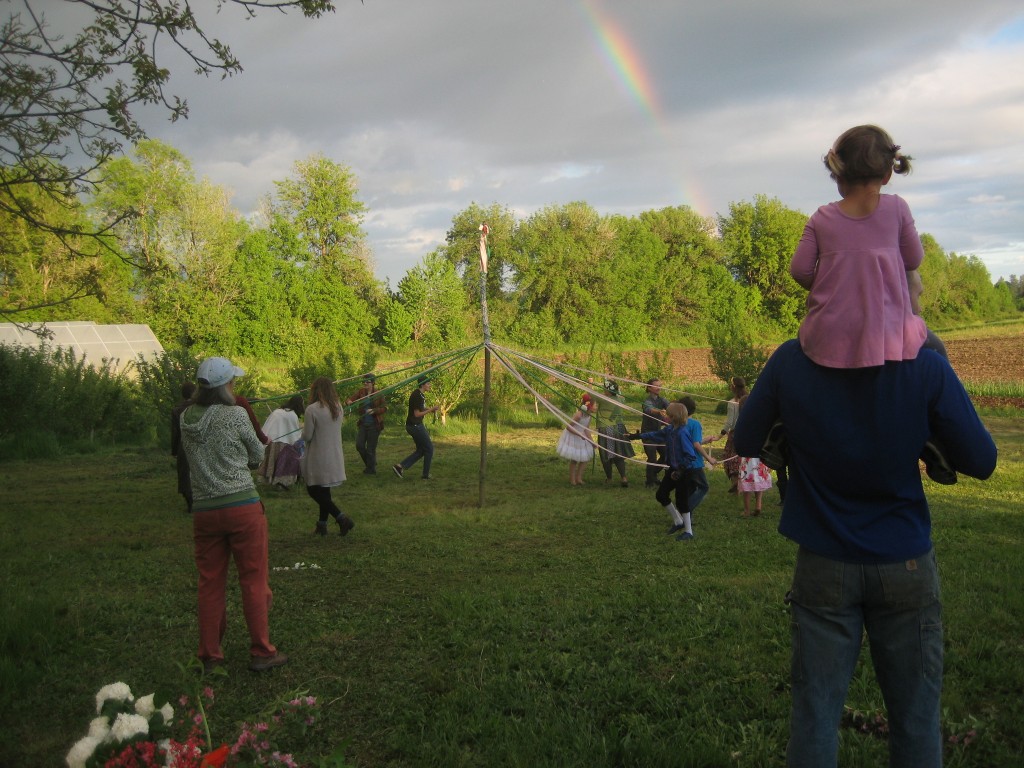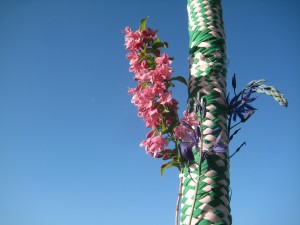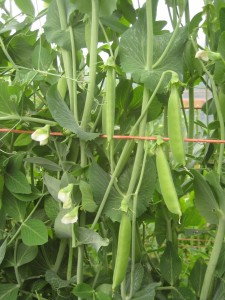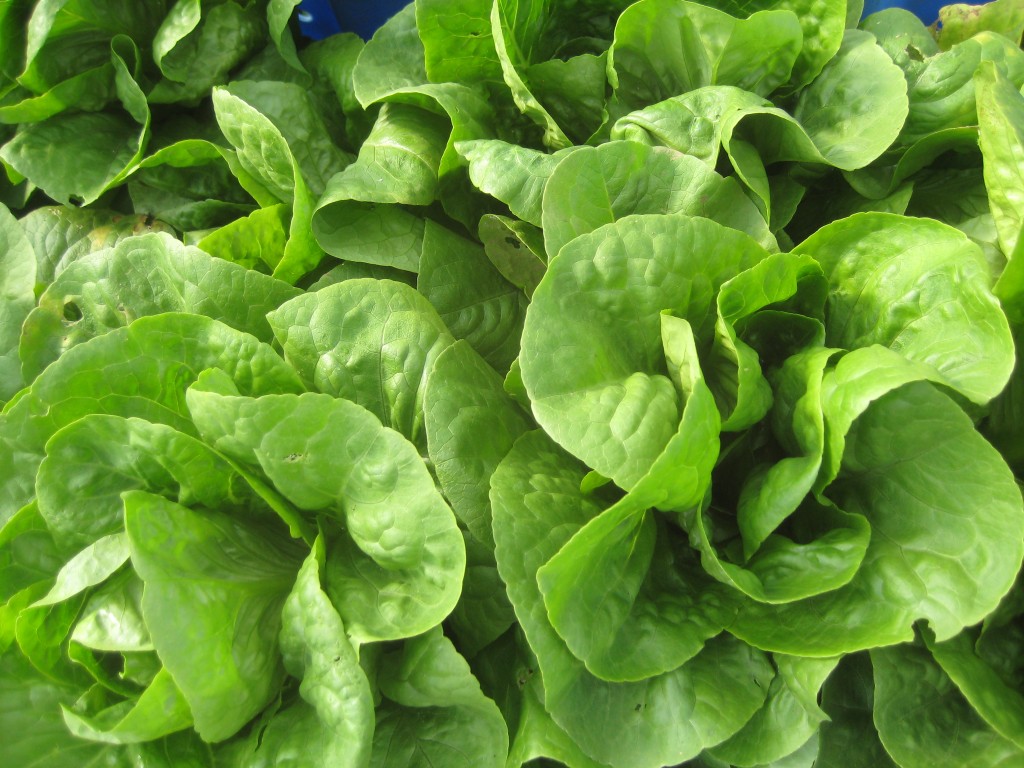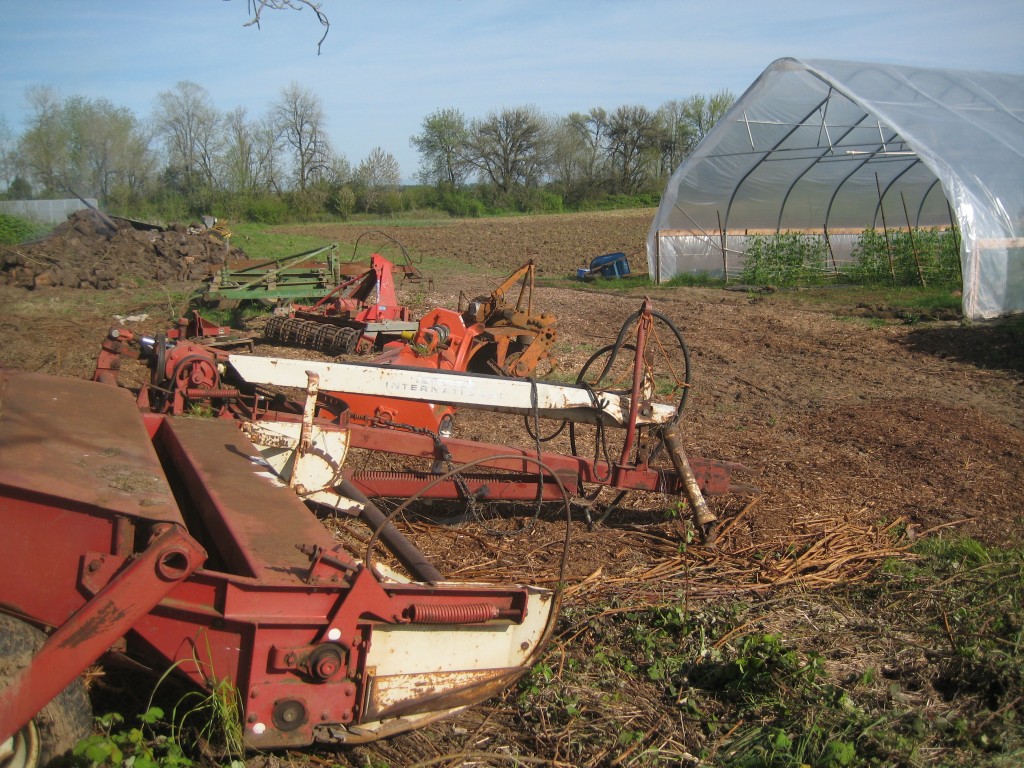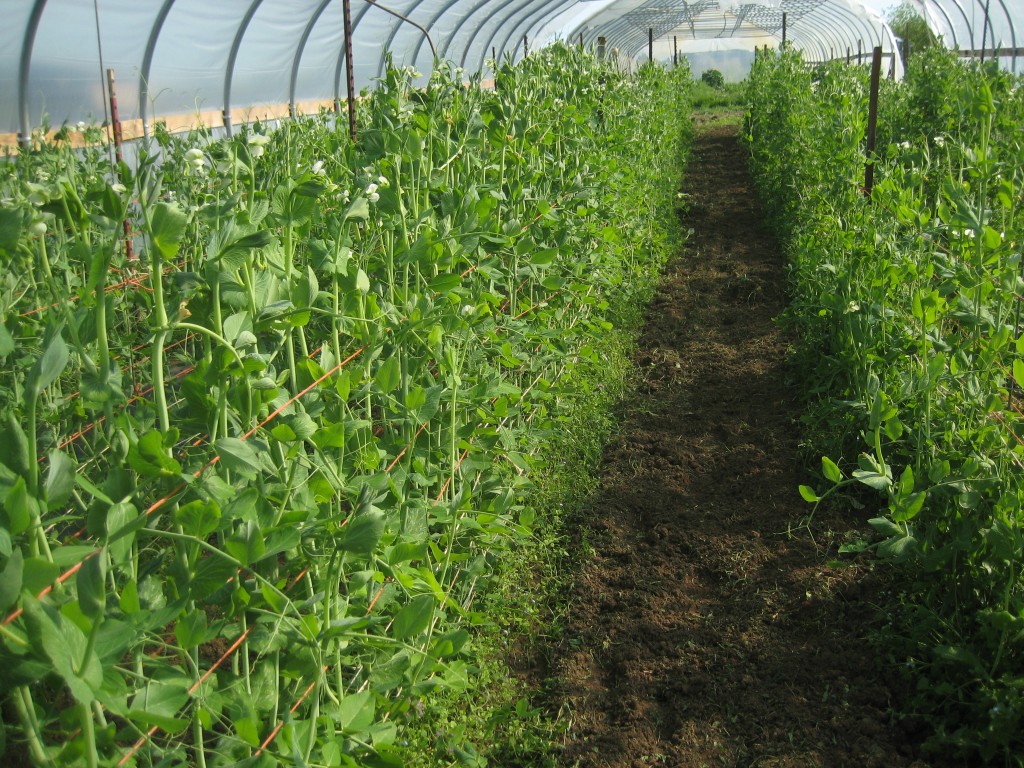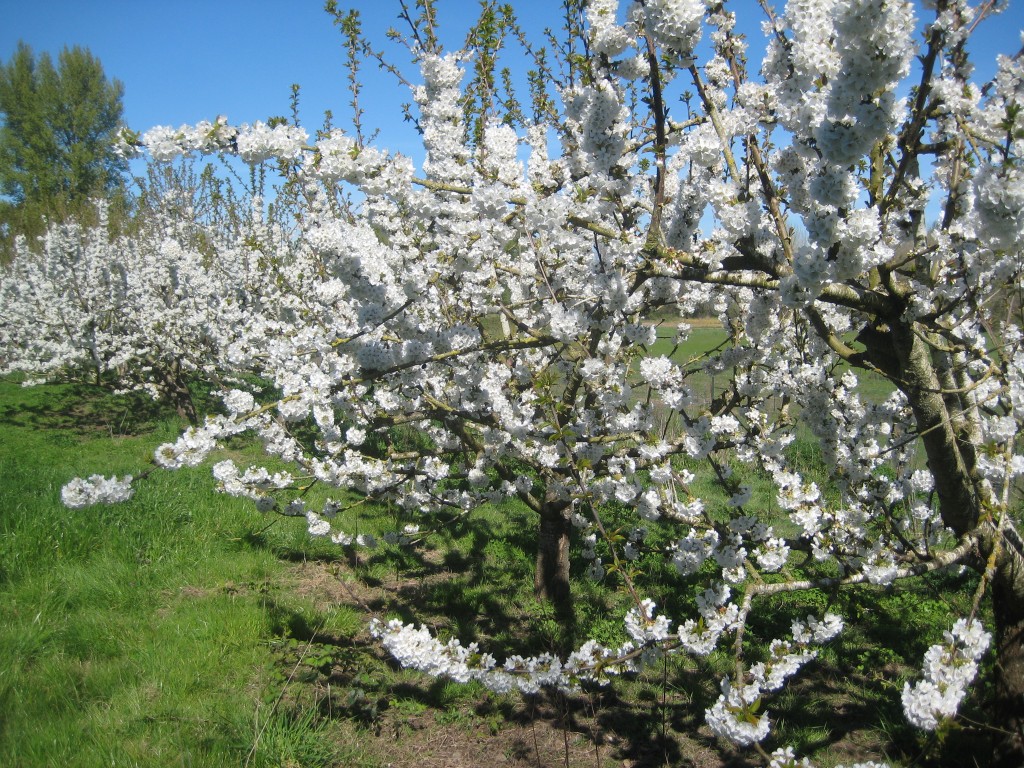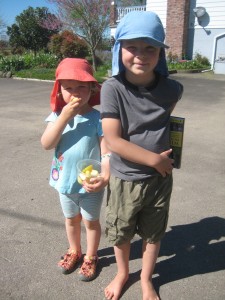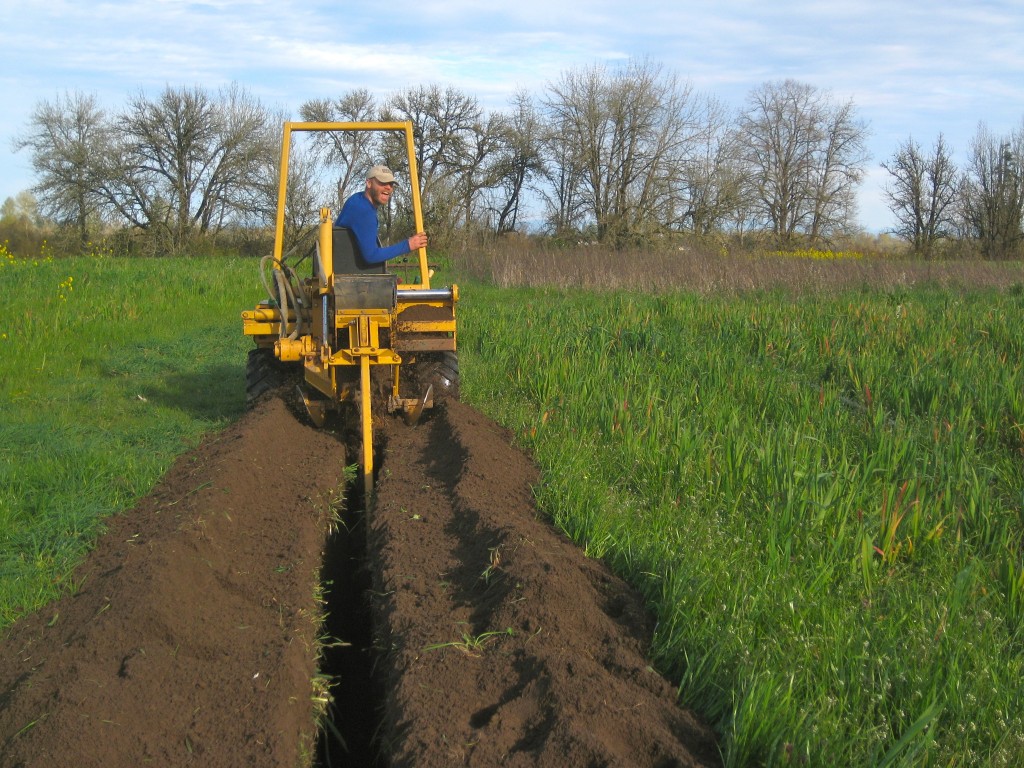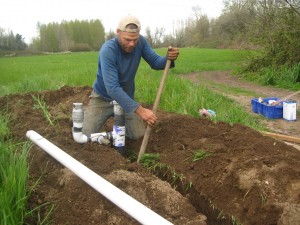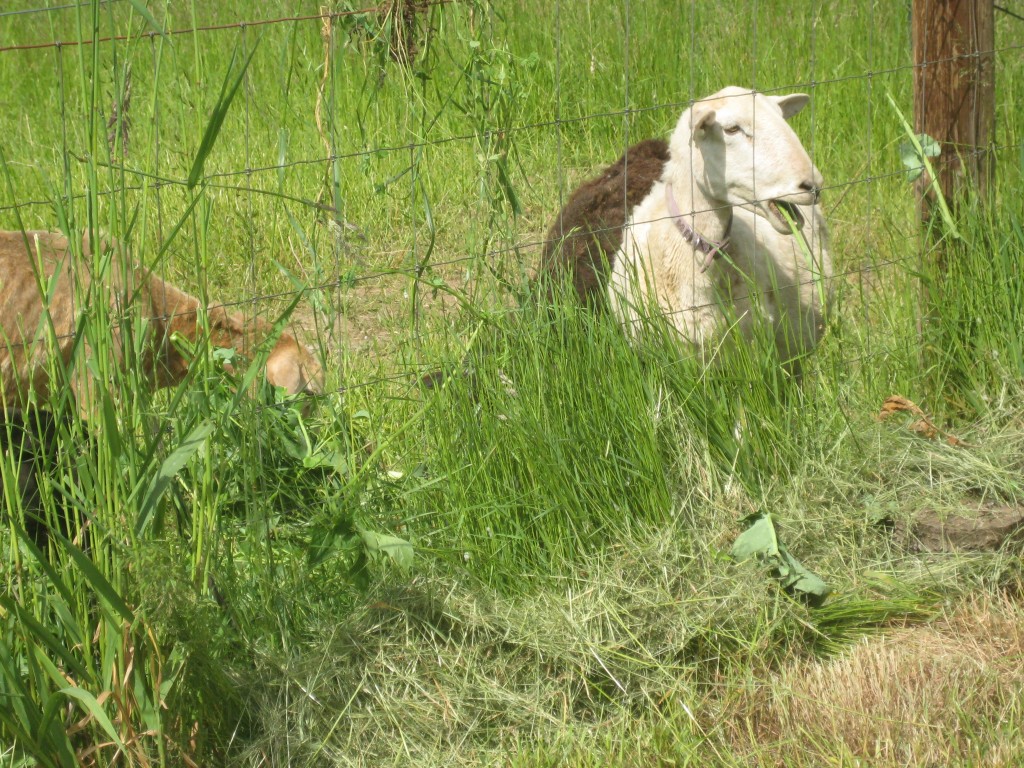
The sheep gathered along the fence this afternoon, to munch on the pea plants we tossed over the top.
Today Casey I picked the last of the peas in one of our greenhouses. The two rows of plants had long ago outgrown our last trellis line (which was at the top of the posts) and was falling over in the paths. We carefully lifted up each section to pick the remaining good peas and noted that the plants were starting to dry down and yellow, and most of the peas were at the very ends of the plants. Sure signs that the plants were ready to stop putting on fresh new green peas and would start “maturing” the peas they’d already set — given that we’re growing these particular plants for fresh eating, edible-pod snap peas, that meant that their time with us is done. Unless we wanted to grow seed, we wouldn’t be excited about the next stage.
So, after picking, we began pulling down the trellis lines and hauling the still green plants out to the sheep and goats, which are pasturing nearby. They happily ran to our piles of pea plants to munch on the nutritious plant matter left there. We are always so happy when we see parts of the plant that we can’t “use” as human food be so heartily enjoyed by farm animals in this way. There’s a profound sense in that moment of the farm being a complete system, with fertility cycling in and out of the ground (up through the plant and back down through the manure — with a lot of sun ray goodness in between).
We will miss this experience next year.
Because, also today, I realized that we have a plan for every single animal left on the farm. The last of the hogs left a few weeks ago (more bacon and ham coming to the storefront soon!); two beef animals and three goats leave in early June; one more beef animal and our sheep will leave in late summer; our flock of laying hens will leave in November. Most of these animals are leaving our farm via the butcher, to be turned into nutritious food for our customers. But two of the oldest ewes will be returning to their earlier home on my parents’ home, to live out a happy, spoiled retirement in the cherry orchard.
For the first time in four years, there are only full grown animals on our farm and no baby animals who will grow up and stick around until future years. There are no chicks, no piglets, no lambs, no kids, no calves, no turkey poults.
We’ve been vague until now about what exactly we are doing with animals on our farm. We knew last year that we wanted to scale way back and slow way down with what we are doing, which is why we intentionally stopped breeding any animals toward the end of last season. But I don’t think we knew until perhaps even today that we were truly done with animals on this farm.
I should always add the important (and very true!) caveat: for now. We are done with animals on this farm, for now.
For Casey and me, coming to this decision took time. There are so many wonderful benefits to having a mixed animal and crop farm. We have relished many parts of this experience. We have especially loved providing a reliable source of grass-raised meat for our customers and our own family.
But this will be our fifth season having animals on our farm, and at this point we feel like our farm needs a break. The tricky thing about raising animals (especially when breeding them as well) is that there are no built-in breaks. There are seasons to the work, but there are always animals to care for in every season. And, they need tending every day. In this way, raising animals is a profoundly different experience than growing crops.
We knew all the challenges of raising animals before we jumped into it — that’s why we waited six years to give it a try! In those early years, people often asked us why we were raising vegetables and not animals, and I’d joke: “Lettuce doesn’t run away!” It was a glib response that was also true.
I don’t feel like I can say that any part of the animal raising experience really surprised us, except that I don’t think we were quite prepared for the weight and the gravity of the work. When dealing with other sentient, living beings, farming takes on a different level of seriousness. Working with them is also inherently a higher risk activity as well — well designed handling systems can help here, but ultimately they only buffer the farmers from the risk rather than eliminating it. Turnips don’t kick farmers in the head; cows can and do and have. Meanwhile, the inevitable losses from our mistakes or natural happenings weigh heavy on our hearts. There’s an emotional and physical toll we have never experienced while growing fruits and vegetables.
And, I have to admit, the double whammy of raising animals and raising children is a profoundly exhausting emotional set of endeavors!
There are other practical considerations too — profitability, butchering logistics, feed sourcing, etc etc etc. Rather than going into too much detail, I will just summarize by saying that good farm-produced meat and eggs and milk really does need to be at least as expensive as it is, and probably should cost even a bit more!
So, again, we feel ourselves cutting some of those metaphorical psychic “strings” I spoke about in an earlier newsletter this year. Or, at least, preparing to cut them at the end of this year. Although at this point, each set of animals that we load to leave the farm represents a cut string I suppose. We see them off with gratitude in our heart for what they have contributed to this place and to our bodies and to our customers.
It’s funny to be writing so many newsletters this spring along this theme of scaling back. It’s a fun topic for us right now and one that we see playing out in other people’s lives now too — in fact, I am leading a panel discussion on the topic of “scaling back” at a farm conference this fall! Yet, each time I sit down to write a newsletter like this, I do marvel at how there can still be more things that we are cutting back on. I suppose that just goes to show how very much we have been doing out here in recent years, with 100 acres in our management and every kind of crop and animal in rotation on that land and many more hands helping with all of it! And, when I look at what we are doing each day, what we are harvest, what we are growing — it is still so rich and diverse. And becoming so much more fun every day for us as we bring it back to a family scale.
A CSA member pointed out to me this last week another really positive point. Each time we cut back on something, such as producing animal products, we open up a niche for another farm. Amen amen amen. I love thinking about this, and knowing without a doubt that other farms are also growing and changing and adding enterprises and experimenting, and that there will be another farm (or several) out there who step up next year to grow healthy animal products for us all. I am already grateful to them.
And, one last word about animals products as a whole, and specifically meat. As an adult, I have never eaten meat casually. In fact, for the first six years of Casey and my married life, we didn’t buy meat for ourselves to eat, because, well, it’s an emotionally and spiritually heavy thing. At the time, we didn’t really know yet about farm-raised meats, and we certainly didn’t want to participate in the factory farm machine. We began buying meat again when we moved to Oregon and met animal producers and visited their farms. The question of “to eat” or “not to eat” with meat is so big, and I can’t really begin to tease out all the ethical, health, ecological, and spiritual questions about it in one newsletter. I think that in general, the decision is more complicated than most vocal parties allow, and there is no easy answer. Our being humans in the world who eat food has an impact, and it’s truly hard to get out of that!
But I want to say that after living in intimacy with domesticated animals for the past five seasons, our respect for life and the gift of life and the gift of nourishing food has grown deeper and deeper. The significance of it all is something we can never ignore or forget — the gifts are so a part of our every cell (literally) that we live with all these animals in us. As much as I, personally, feel that healthy animal products are an important part of my diet, I also feel the weight of that choice too. There is a huge responsibility to live a life that is worthy of what we take in each day.
So, to that end, I want to close with one of my favorite Wendell Berry poems. Long ago, when we lived at Holden Village, this was printed on the laminated “grace” cards that were on all the dining room tables for use before meals. But it’s actually intended to be a prayer for after eating (as the title indicates), and it’s one that I try to reflect on as regularly as I can after my own meals:
Prayer after eating ~ Wendell Berry
I have taken in the light
that quickened eye and leaf.
May my brain be bright with praise
of what I eat, in the brief blaze
of motion and of thought.
May I be worthy of my meat.
Enjoy this week’s vegetables! (And whatever other nourishing foods you might eat too!)
Your farmers, Katie & Casey Kulla
~ ~ ~
Meat — what’s coming up:
Just so there is no confusion, we will still have meat on the pick-up through the end of this season! (As well as filling a few individual orders.) There should be a plentiful supply of meat in the freezer at all times. If you’d like a head’s up of what to expect, here’s a rough outline of what we’ll have and when:
- Now — ground pork and chops
- Soon — bacon and ham
- Late June — ground beef, goat (ground and cuts)
- Early fall — ground beef, beef cuts, lamb (ground and cuts)
- November — stewing hens (these will be available for purchase at the final CSA pick-up as well as the two Holiday Harvests at Thanksgiving and Christmas)
If there’s anything you’d like to reserve in advance, please let us know so we can try to insure you get what you want!
~ ~ ~
Meet this week’s vegetables:
- Strawberries
- Radishes — The first of the radishes from the field! Radishes are typically the first of the first field-grown crops each spring, and they always seem like an important milestone in the year. They also happen to be delicious. We ate some with lunch. I sliced them a little thick and we used them to scoop up bites of chicken salad (like a cracker). What a spring treat!
- Sugar snap peas — It’s highly likely that these will be the last of the spring snap peas! It’s been a beautiful abundant few weeks of peas! Enjoy the last of it! (And more good things are coming up soon.)
- Fava beans — The fava beans are now developed enough that they are great for shelling and cooking as just the inner bean! Some people like to go the extra extra mile and also peel off the white skin on each bean. This is optional — traditionalists swear that it makes for the best flavor (and color), but it’s extra work that you shouldn’t let get in the way of enjoying your fava beans. Once you have your shucked beans, what to do with them? We like to boil them for a few minutes so that they are almost all the way cooked (it really doesn’t take long) and then finish them in a pan with butter and green garlic. They’re great tossed with pasta (that’s very traditional) or mixed into cooked greens or just served on their own with salt.
- Zucchini
- Broccoli
- Cabbage — We have both “regular” cabbage and also “Napa” cabbage (which is actually more closely related to turnips and mustards — great for stir fries and Asian flavored ginger cole slaw).
- Chard
- Winter squash
- Potatoes
- Garlic scapes
- Green garlic
And this week’s extra goodies from the farm:
- Eggs — $6/dozen
- Pork chops — $12/lb
- Ground pork — $8/lb
- Pork organs, fat & bones — $4/lb

